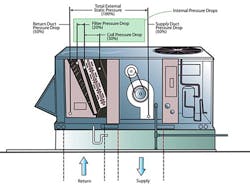Static pressure measurement on commercial HVAC systems can vary significantly from one type of equipment to another. Commercial pressure testing also requires the balancer to interpret and report internal equipment pressure drops. To remain savvy on the latest commercial air pressure testing, let's take a look at this latest commercial pressure testing update.
Packaged Equipment
Commercial rooftop equipment is frequently used in commercial applications today in most regions of the country. Packaged equipment 7.5 tons and larger offer some unique challenges that you should be aware of to avoid interpreting pressure readings inaccurately.
Total External Static Pressure
Generally, when measuring total external static pressure, measure the pressure at the point where airflow enters the equipment and where the airflow exits the equipment. The pressure entering the equipment is a suction or negative pressure. The pressure exiting the equipment is a discharge or positive pressure. Add these two pressures together to find the equipment measured total external static pressure.
Remember to drill test holes above the curb, since the curb is considered external to the equipment.
Example: A 10- ton packaged unit in a rooftop application placed on a curb.
- Equipment entering pressure - .46-in. w.c.
- Equipment exiting pressure +.51-in. w.c.
- Total External Static Pressure .97-in. w.c.
Compare the measured static pressure to the equipment rated maximum total external static pressure to assure the system is operating at less than the maximum rated total external static pressure as rated by the manufacturer. Disregard the + and - signs as these represent the type of pressure measured and are not numerical values.
You can also use the measured total external static pressure and the measured fan RPM to plot fan airflow on the manufacturer's fan performance table or fan curve.
Plotting Fan Airflow and Internal Equipment Pressure Drops
Measured total external static pressure is used to plot fan airflow…but here's where things begin to get tricky. Prepare yourself, here comes the techy stuff.
Remember, the filter and coil pressure drops are not “visible” to the total external static pressure reading, so what if the filter and coil are dirty and have loaded up through normal equipment use by the time you balance the system?
When equipment is started up the first time, equipment is new, and the filter and coil are clean. Ideally, the filter and coil pressure drops should be taken and recorded on the equipment for future reference. These baseline tests can be referred to whenever system pressures are measured.
If the filter and coil pressures change over time, the increased pressure of these components should be added to the measured total external static pressure before plotting fan airflow.
This is the most accurate way to interpret static pressure when plotting fan airflow for a packaged unit.
"As shipped" is a term being circulated around the industry recently that brings clarity to static pressure measurement. When considering how to measure total external static pressure, and determining if a component of a system should be included or excluded in the total external static pressure reading, determine if the component was included with the equipment “as shipped” or as it was tested in the lab.
What if No Pressures Were Taken at Start Up?
If no filter and coil static pressure readings were taken at start-up, ideally you can find manufacturer's data to determine what these components were rated at when the equipment was laboratory tested. The bad news is that many manufacturers do not make this data publically available.
If no manufacturer data is available for filter and coil pressure drops, the next best thing is to use NCI pressures budgets as a default. Research has provided some typical pressure drops for filters and coils in well-operating commercial equipment.
Filter Pressure Drop —To estimate clean filter pressure drop, multiply the rated fan static pressure by 20%. If the filter pressure drop exceeds 20% of the rated total external static pressure, add the excess filter pressure drop to the measured system total external static pressure before plotting fan airflow.
Coil Pressure Drop —To estimate clean cooling coil pressure drop, multiply the rated fan static pressure by 30%. If the coil pressure drop exceeds 30% of the rated total external static pressure, also add the excess coil pressure drop to the measured system total external static pressure before plotting fan airflow.
Internal Pressure Drop
Example using the example in the illustration above, let’s say this packaged unit is rated at 1.00-in. TESP. According to the NCI budgets, the filter pressure drop should not exceed .20 in. and the coil pressure drop should not exceed .30 in.
Say the filter pressure drop measured .35 in., exceeding budget by .15 in. The coil pressure drop measured .50 in., exceeding the coil pressure drop budget by .20 in. Add together the excess pressure drop of the filter and coil that exceeded the budget (.15 in. and .20 in. to find that the internal pressure drops exceeded budget by .35 in. Add the .35 in. to the measured total external static pressure of .97 in. (35 in. + .97 in. = 1.32 in). Then plot fan airflow using the total external static pressure of 1.32 in. with the measured fan RPM to determine fan airflow.
Your ability to measure and interpret static pressure is essential to improving the performance of the HVAC systems you sell, install and service.
As you can see from the complex nature of this article, hopefully you will never stop learning better ways to measure and interpret static pressure.
Rob “Doc” Falke serves the industry as president of National Comfort Institute an HVAC-based training company and membership organization. If you're an HVAC contractor or technician interested in a free Commercial Static Pressure Test Procedure, contact Doc at [email protected] or call him at 800-633-7058. Go to NCI’s website at nationalcomfortinstitute.com for free information, articles and downloads.
About the Author
Rob 'Doc' Falke
President
Rob “Doc” Falke serves the industry as president of National Comfort Institute an HVAC-based training company and membership organization. If you're an HVAC contractor or technician interested in a building pressure measurement procedure, contact Doc at [email protected] or call him at 800-633-7058. Go to NCI’s website at NationalComfortInstitute.com for free information, articles and downloads.

